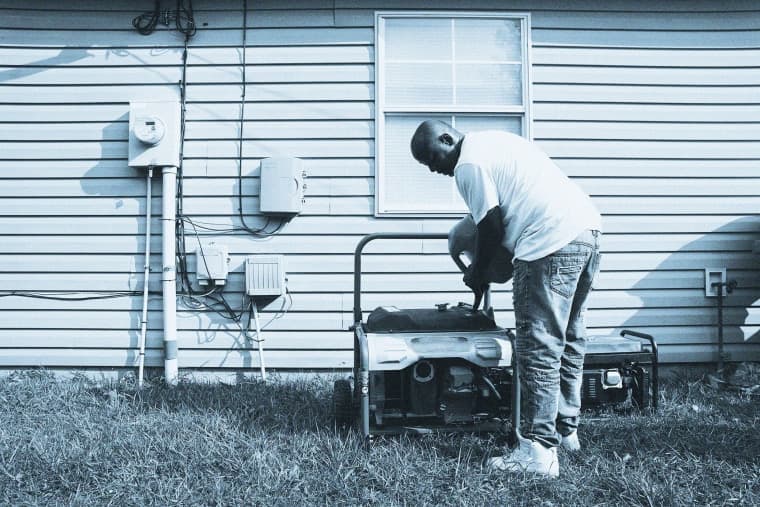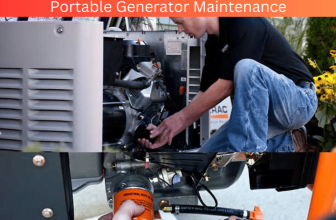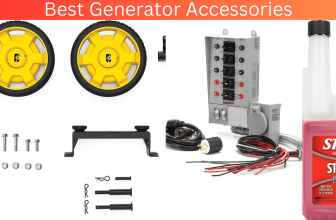
Are you experiencing some issues with your portable generator? You’re not alone in this struggle. These devices can prove challenging for many users due to their occasional lack of reliability. These issues can result in time consuming attempts at diagnosis and repair. Luckily, I’m here to offer assistance! In this article, I have compiled an easy to follow solution guide that will get your portable generator working like new again.
This guide is packed full of helpful tips for troubleshooting common problems related to portable generators. By following its advice on identifying issues such as fuel blockages or ignition failure users can quickly get their machines working properly again.
From essential maintenance tasks such as oil changes and spark plug replacements to more complex repairs requiring specialized equipment this resource has got every issue covered in a step by step manner. With access to the right tools and knowledge provided by this comprehensive guide, you’ll be able once more enjoy the convenience of your trusty portable generator without fail!
Troubleshooting Tips
It’s never fun when your portable generator isn’t working as expected but fear not! I’ve compiled some helpful troubleshooting tips that will help you tackle these issues head on. Before jumping into any repairs though, always remember to prioritize safety first – disconnect all power sources before commencing any work.
With safety measures in place, let’s begin by thoroughly inspecting all connections for potential faults. If power still isn’t restored then inspect other areas like checking whether there’s enough fuel or oil present within the fuel system whilst also examining cables/parts for signs of wear or damage requiring replacement.
When everything appears okay yet your generator still fails to function properly, more advanced technical knowledge may be required which is why seeking professional assistance is advised.
By following these tips and identifying common issues that might have caused your portable generator to fail, you should be able to restore its functionality in a jiffy!
Identifying Common Issues

We’ve tackled some basic troubleshooting tips already, now let’s delve deeper into identifying common causes of portable generator issues.
The first place to check is the fuel system. This tends to be one of the most frequent factors contributing to issues with generators. Inadequate fuel levels or stagnant, old gas can lead to insufficient power generation output. Before attempting to start your generator, make sure both fresh gasoline is used and that there is enough in the tank for optimal performances.
If difficulties persist after/with these initial checks, it may be worthwhile investigating further by inspecting other key components such as spark plugs and air filters elements .
As neglected/old parts/clogged particles in either component can ultimately result in malfunctioning generators leading again reduced efficiency or inability for proper startup.
The key takeaway? Keep these essential parts up-to-date with regular maintenance – replacing parts when necessary – to ensure maximum functionality for your portable power source when you need it most.
Checking The Fuel System
Your generator will perform optimally only if its fuel system is functioning effectively, therefore, regular inspections are necessary. In particular, it is important to take a closer look at the fuel line and filter regularly for any wear or blockages. Heres how:
1 Check whether or not you need to replace the fuel filter after evaluating its condition.
2 Inspect all sections of your fuel line for damages or obstruction.
3 Carefully seal all gas tank caps tightly to avoid air leakage.
4 Wipe off any dirt from the carburetor and air filter housing.
5 Verify that the choke has proper operation functionality.
If you have doubts about examining these components, independently consider seeking advice from an expert in portable generator maintenance. Ensuring your generator operates correctly can save you both time and money in the long run
Now that we’ve gone over checking the fuel system, let’s move to testing your portable generator’s battery to ensure it turns on when needed.
Testing The Battery
Our fuel system evaluation is complete, hence, let’s move onto verifying the state of our portable generators batteries.

Begin by taking care while removing it from terminals and placing it aside in a protected environment earmarked for testing purposes. Leveraging a multimeter assess voltage and amperage – indicating how much energy remains within the battery at this time.
After understanding its position, examine closely for any issues like signs of corrosion or damage that may mean we require an immediate replacement. New batteries can be obtained either from local hardware stores or through online retail sites. Coming back to our engine checkup, let us evaluate critical components like spark plugs, air filters and valves further down the line when conducting maintenance checks on other parts!
By investing time and effort into troubleshooting issues around these areas earlier in problem identification stages could help keep everything running smoothly while ensuring optimal performance levels are maintained throughout usage intervals!
Examining The Engine
There’s no point in attempting repairs on your portable generator without first thoroughly examining its engine. If there’s anything wrong with the engine tinkering around with parts won’t do any good at all—so it pays to investigate each component thoroughly. Here are some essential components you should inspect:
- Carburetor
- Air Filter
- Spark Plug
The carburetor makes sure that precisely enough air mixes with fuel when entering an engine. This mixture ratio is crucial for proper functioning of your generator.
Meanwhile, an air filter eliminates debris and dust from entering while allowing steady airflow through the system as needed. Lastly (but certainly not least), a spark plug ignites fuel so that combustion can take place within cylinders—the very essence of what powers up your generator.
Check to ensure these components are all correctly connected, free from debris and damage.
Keep in mind that a flawed carburetor or restricted airflow will cause difficulties upon startup while a defective spark plug will prevent any combustion inside cylinders – meaning no start up at all! Once you’ve looked for potential issues concerning these components its crucial to inspect your spark plug more thoroughly for proper diagnosis purposes.
Inspecting The Spark Plug
Now that we’ve combed through the engine with precision, let’s direct our focus onto another pivotal component – The Spark Plug. It is responsible for igniting fuel and creating combustion that drives your generator forward. Remember to inspect it regularly for wear/tear signs of corrosion/malfunctioning as it plays a vital role in optimizing performance levels. Begin by removing it from its socket by utilizing either a socket wrench or model-specific tool at hand.
Carefully scrutinize it for deposits, cracks or other forms of damage that could impact function- if any such concerns arise, make sure you replace them right away.
Up next is cleaning your air filter. A less-discussed considerate yet a crucial factor impacting efficiency significantly while reducing strain on your generator unit. A clogged filter puts unnecessary load unnecessarily affecting operations negatively. Thus regular cleaning/replacement is key to ensuring smooth running & maximal power generation alike.
So without further ado – Let’s dive into quick & easy methods of getting this chore done.
Cleaning The Air Filter
To keep your portable generator running smoothly over time requires regular maintenance – one key step being cleaning its air filter as needed. This vital component helps block out dust, dirt and other debris from entering into the engine area which could cause issues such as unwanted damage if not cared for properly.
In this section, below we’ll give you guidance on how to effectively clean your generators air filter so it performs to the best of its ability every time you need it.
Begin by removing the air filter cover which is typically held in place with screws or bolts. Once off, inspect the filter for any signs of wear and tear dust buildup, or debris accumulation. If you notice these issues – then cleaning is in order!
Cleaning methods depend on whether your generator has a foam or paper based air filter material type. Foam filters can be vacuumed while paper ones require the use of compressed air only to avoid tearing.
Once cleared of dirt and grime re-attach the cover securely with screws/bolts before using your generator again. Remember that proper maintenance like this can help keep your machine running safe and strong for years to come; a win win situation overall!
Replacing The Oil

Maintaining a portable generator might seem like a daunting chore but trust us, replacing its engine oil regularly is fundamental to ensuring reliable operation and longevity in the long run! But where do we start? Firstly, find out what type of motor oil is appropriate for your model with no lower than 10W 30 viscosity rating available within easy reach.
Not quite clear which type suits yours best? Look through the manual or consult an experienced mechanic!
Now that our preparation is sorted let us proceed further.
The next step is draining all the old oil into a container that can handle unwanted fluids only (not one meant for food or drink). Afterward, remove any debris, both inside and outside of the generator.
Once you’re pleased with the cleanliness level, fill up with fresh motor oil until it reaches your generators required capacity as indicated by the manufacturers manual – usually around one quart per gallon.
Take a moment to check whether any filters or spark plugs need replacing as well before making sure everything is connected correctly before starting your machine.
At this point you’re ready to reignite your portable generator and savor its advantages for years down the line with proper upkeep.
It’ll provide unwavering service if handled well. The next vital stage is tackling the alternators troubleshooting process guaranteeing that your generator keeps running without any issues.
Troubleshooting The Alternator Issues
Dealing with a malfunctioning alternator is an undeniable headache. But before giving up on your generator entirely follow these straightforward troubleshooting steps below. Kick off by verifying that both battery charge and connections are working properly. Sometimes issues bite from happen stance like loose wiring or lack of power supply.
From there, investigate finer details like engine oil level and spark plug health which play major roles in keeping things running smoothly. For owners of generators equipped with oil filters make certain to swap them out regularly for optimal performance too.
Though in some cases after exhausting all options individual mechanisms within the alternator such as rotors or stators may require replacement which is no small task requiring expert interfacing.
Remember: preventive care and consistent maintenance can extend the lifespan of any machine – including your trusty generator. To ensure that your generator runs effectively throughout its lifespan there is a need for consistent maintenance checks.
With this approach comes an assurance of having a reliable source during power outages or emergencies.
Are you eager to find out what’s involved in performing routine maintenance on your unit? Then read on!
Performing Regular Maintenance
Once you’ve tackled troubleshooting the alternator it’s time to shift attention towards performing regular maintenance on your portable generator. This aspect is absolutely critical in ensuring optimal and effective performance over time.

Thankfully, maintaining your generator isn’t especially difficult or time consuming with these straightforward steps: regularly checking for appropriate oil levels – adding more if necessary with oil of a matching type as what’s already inside. Double checking for fuel leaks and verifying that all connections are secure; attending promptly to any issues you identify before they can snowball into bigger hassles down the line; remembering every few months or so to inspect spark plugs and swap them out as needed. Taking these simple measures will go a long way towards ensuring seamless operation of your generator year after year.
So invest some extra minutes now — it’ll pay off later.
Frequently Asked Questions

How Often Should I Perform Regular Maintenance On My Portable Generator?
Owning a portable generator comes with significant responsibility, namely making sure it receives proper upkeep at regular intervals to avoid serious issues.
Every month or two (depending on usage) take stock of crucial components such as the spark plugs and oil filters.
This proactive approach keeps your generator running smoothly while also reducing the chance of issues such as unexpected breakdowns or complications later on. Reliable power is just one step away: prioritize routine maintenance today!
Can I Use Any Type Of Oil For My Portable Generator?
While taking care of your portable generator its crucial not to overlook its vital lubricant – the right kind of oil can make all the difference in its longevity and efficiency.
You do have freedom when choosing which one to use but consider diving into the owners manual first for guidelines from the manufacturer themselves.
To ensure smooth operation over time look for oils designed for small engine use while paying attention to its recommended viscosity.
What Type Of Fuel Should I Use In My Portable Generator?
Your portable generator is a valuable asset during emergency situations or outdoor activities – but are you giving it the right kind of fuel?
Selecting the appropriate type is key in keeping your engine functioning properly in the long run.
Go for small engine formulated gas rather than standard ones; think those typically used for mowing lawns and suchlike.
Keep an eye out for gasoline with elevated levels of ethanol content too – these could harm your equipment over time. If unsure on which specific kind works best, don’t hesitate to refer back to your user manual or leave it up to an expert.
How Do I Know If My Portable Generator Is Emitting Too Much Smoke?
For those using portable generators as backup power sources or for outdoor work projects alike, determining if their equipment produces an unacceptable level of emissions can pose a concern. Smoke output from generators can indicate issues with combustion efficiency or even engine upkeep requirements hindering performance over time -issues that require prompt correction to help ensure continued reliable use safely downstream without worsening environmental impact during usage alone!
Users should make sure to verify their unit’s output safety by observing the coloration (“black” vs “gray”), as well as any notable smells.
Fuel-burning inadequacy is typically indicated by a “black” smoke, whereas the presence of oil leakage can be accompanied by a strong odor. When either issue arises, it’s best to arrange for maintenance or repair right away.
How Often Should I Check The Spark Plug Of My Portable Generator?
Nobody wants their portable generator to break down unexpectedly – not only can it be costly but also inconvenient! To avoid these issues entirely regular maintenance checks are essential – including inspecting the spark plug every couple of months.
This isn’t complicated; begin by cleaning around its location then using a wrench to remove it.
Take note of any damage that needs attention like cracks or corrosions which could lead to more significant problems if not addressed early on; remove any residue build up too while you’re at it! By incorporating these checks into your routine your machine will operate smoothly without interruption.
Conclusion
To maintain safety and reliable functionality of your portable generator, taking care of it is very important. Regular maintenance helps you minimize potential issues while using appropriate fuel and oil types that are essential aspects requiring consideration when handling generators.
Additionally, monitoring smoke emissions as well as periodic spark plug checks are imperative practices too. Therefore, adhering to simple procedures explained in this guide should provide adequate information on how to keep your generator running as expected for years while avoiding issues that need hefty servicing fees in future.





